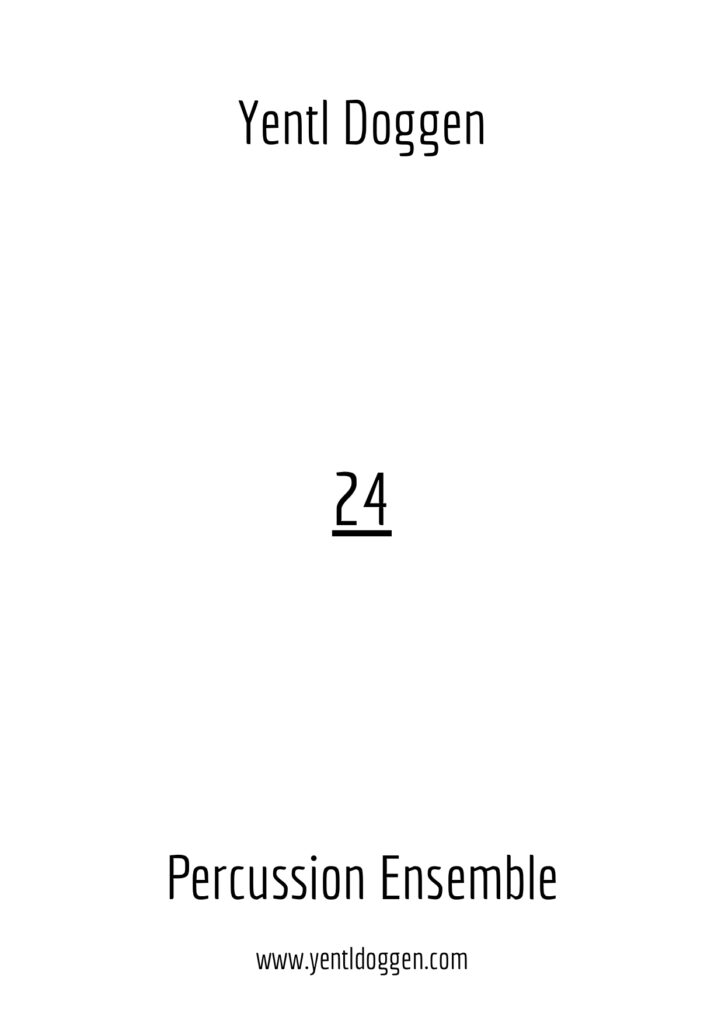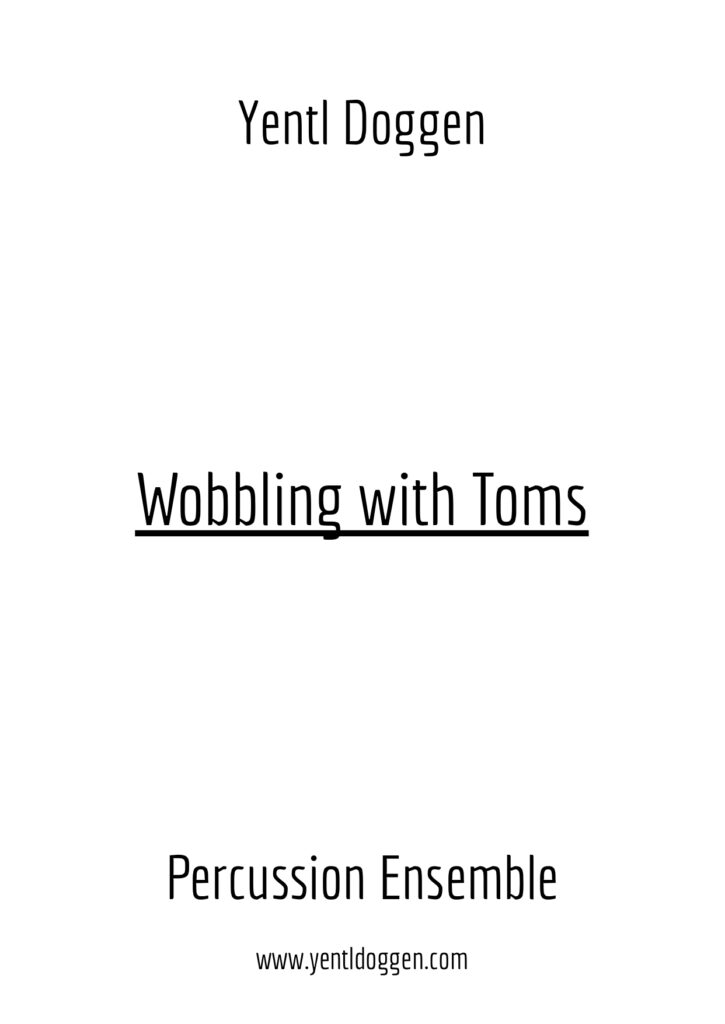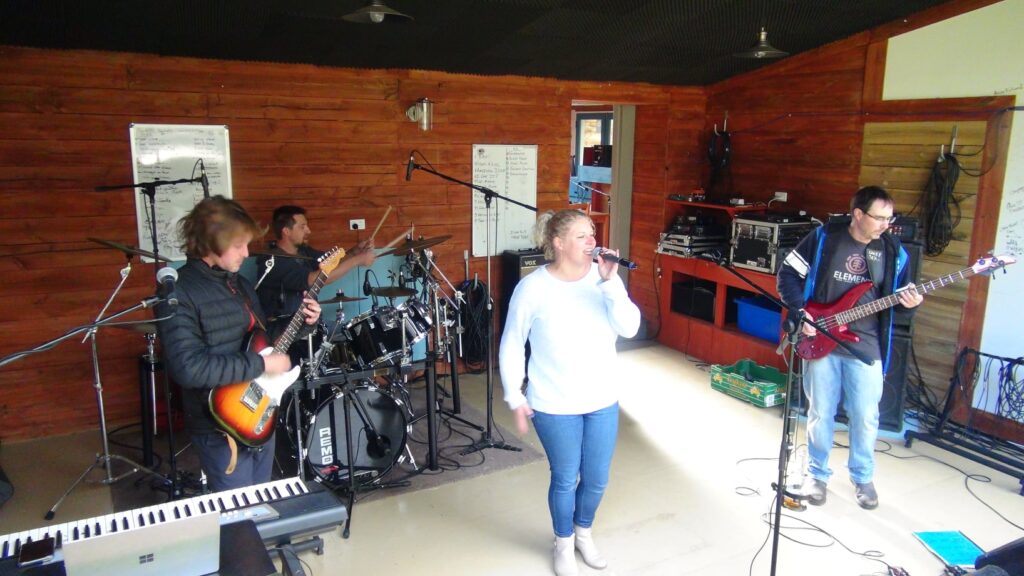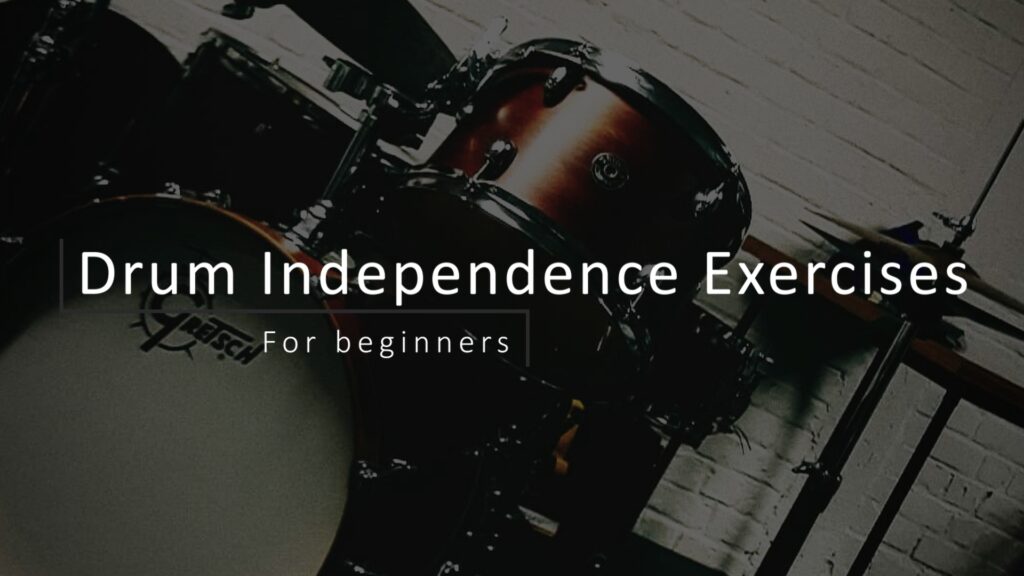Drum Transcriptions, Music
Mastering the Art of Reading Drum Sheet Music and Drum Transcriptions!
Drum Sheet Music, Drum Transcriptions and Drum Scores are all terms for the same concept: Sheet Music in classical music notation to play on a drumset. Drum Transcriptions are an essential tool for drummers who want to play along with songs and understand their structure better, learn new beats and fills, or become masters of sightreading. In short: drummers who wish to become better drummers. Besides, many paid musical settings rely heavily on Drum Sheet Music as it allows the player to pick up the song and its grooves immediately.
For the more experienced drummers, terms such as grooves, beats, fills or even reading Drum Sheet Music might be very familiar. However, everybody has to learn, and that’s what this post is about: Mastering the Art Of Reading Drum Sheet Music and Drum Transcriptions. We’ll explore how to read various drum transcriptions, from the basic notation to the more advanced notations.
At its core, Drum Sheet Music is just like any other form of sheet music. The only exception is that it is explicitly written for the drums. Learning and practising how to read Drum Sheet Music can be challenging for a beginner. But, the rewards afterwards are immense. By learning to read notation, you can play a broader range of styles and songs, communicate effectively with other musicians, and ultimately develop your unique sound behind the drumkit.

Basic Music Notation:
Before diving into the specific Drum Sheet Music notations, it is essential to understand the basics of music notation. The good thing is that these things serve a bigger purpose than Drum Transcriptions and are widely known music theory concepts.
The Staff:
The staff forms the foundation of music notation. It consists of five horizontal lines and four spaces in between. In a general way of reading music sheets, every line or space between the lines represents a different musical pitch. However, when reading percussion or Drum Sheet Music, they represent a different drum or cymbal.

Time Signatures:
Time signatures are widely used to indicate the number of beats in every measure of music. The most common time signature in Drum Sheet Music is 4/4 because most popular songs are written in that time signature. It means that there are four beats in every bar. Other typical time signatures are 3/4, with three beats in every bar or 6/8, where six eight notes form a bar. Although it doesn’t often happen in pop-music culture, music pieces can change their time signatures throughout the song. For this guide, however, we will stick to the primary Time Signature 4/4.

BPM:
In most Drum Sheet Music, there will be a BPM marker for beats per minute. The BPM will indicate the tempo for the drum transcription and refers to the total number of beats in a minute of music. For example, if a song has a BPM of 120 quarter notes, there will be 120 beats every minute or two per second. Knowing the BPM of some songs by your favourite artist is always handy, so you always have something to compare the given BPM.

Note Values:
Note Values are a bit like bringing mathematics into music. The note values in rhythmic notations represent the duration of each note. The most common values are the quarter, eighth, and sixteenth notes. In 4/4, we can have four quarter notes, one for every beat. Also, in 4/4, we can have eight, eight notes, or two for every beat. The same pattern applies to sixteen notes, with four sixteenth notes in every beat. As rhythmic notations and Note Values can get very complex, and this post is about Drum Transcriptions, I’ll stop with this basic explanation. If you would like to know more about Rhythmic Notation, I suggest keeping an eye on our Music Theory Page, where in the future, I’ll write a guide on Mastering the Art of Rhythmic Notation.

Rhytmic Notations:
Where the Note Values usually represent a single note, the rhythmic notation in Drum Sheet Music combines various notes with different note values to create a specific rhythm or pattern. Most beats, drum fills, and solos combine note values on different drumkit parts, creating unique grooves and sounds. The next chapter explores the notation for other parts of the drumkit.

Drum Sheet Music Notations:
The notations for Drum Sheet Music or Drum Transcriptions are logically constructed. Everything played with the drummer’s feet is usually written on the bottom of the staff. A solid black note means the bass drum is played, whereas an x indicates the hi-hat. Most Drum Score uses the fifth line for the feet. However, it is also possible that the notes are notated below or above the fifth line. If there are two different solid black notes, it usually indicates a double bass drum or a double bass drum pedal is used. If any other notes are written on the bottom of the staff, it sometimes represents a cowbell or tambourine in the feet. In that case, they usually make a note to clarify the extra note.

Everything played with the hands usually finds its way between the first and the fifth line. In almost 99,99 per cent of the Drum Transcriptions, the snare drum is positioned just above the second line. A solid black note stands for a hit onto the skin, whereas an x is used to indicate the use of a rim click. The higher toms, or simply those positioned above the snare drum, are also written above the snare drum, whereas the floor toms are written below the snare drum. In some cases, the notation might differ slightly. It is always good to look at a standard drum groove to see where the author locates the snare drum, or some transcriptions might also have a notation key.

Cymbals:
Everything on the first line or above usually represents either the hi-hat, the ride cymbal or a crash cymbal. If the writer wants you to use specific cymbals, it will note which cymbal relates to a particular note. Generally, if an x is placed on the first line, it represents the ride cymbal. If an x is placed above the first line, it stands for the hi-hat. Everything above represents crash cymbals.

Techniques:
Additionally, to these basic notations, there are specific notations for each element of the drumset. For example, on Toms and the Snare drum, we can play flams and drags as described in the drum rudiments. These techniques add depth, complexity and expressions to drum music. Learning to play these rudimental techniques will allow you to play Drum Transcriptions more accurately and precisely.
Understanding the Elements of a Drum Transcription:
Almost all Drum Sheet Music comes with various rhythms, beats, fills, grooves and patterns. It is essential to know the difference between each and recognise when the same pattern, grooves and beats are played repeatedly. Especially in pop music, it is improbable that every bar has a different groove. A drum transcription is a collection of a few grooves, beats and fills played multiple times. Recognising them will make getting through an entire Drum Transcription easier, especially when sightreading.
Beats and grooves:
A beat is a repeating pattern that provides the foundation of the Drum Sheet Music you are playing. It usually consists of one bar that is played repeatedly. Beats can be notated through a combination of notes and rest. Standard beats are driving rock beats, where the bass drum is played on the first and third counts and a snare drum on the second and fourth counts. However, jazz swing beats and funk beats are also popular uses of beats. Grooves are very similar to beats, depending on what drummer you’ll talk to. Grooves often explain how a beat is played over multiple bars. To make a beat, groove means adding expression and making it more danceable.

Fills:
A fill is a short pattern after a certain amount of beats. It often adds variety and makes the drum part more interesting. In jazz and funk music, a fill usually leads to a particular accent the drummer needs to emphasise. Fills are traditionally built from a combination of the snare drum and various toms and can also include variations on the rudiments.
Repeating sections in Drum Sheet Music:
Drum Transcriptions can get very messy when every single bar is fully notated. Moreover, since most pop songs consist of different sections that are very alike, it is sometimes worth repeating entire units. Most Drum Sheet Music uses four different ways to compress the Drum Score, making it easier to read and shorter to notate. Each of these four ways of repeating serve its own purpose.
Repeating bars:
The one-bar repeat sign consists of a single slash with a dot on both sides. The sign indicates that the immediate previous bar needs to be played again. Variations of the one-bar repeat sign might have the same symbol over two or even four bars. In this case, the previous two or four bars must be repeated. Usually, they write a two or a four above the bar the clarify how many bars need to be repeated. When the first bar has a crash cymbal between brackets, it indicates that that bar needs to be repeated; however, the crash cymbal is only played the first time. In the following bars, this crash cymbal would be replaced by either a ride cymbal or a hi-hat, depending on the further course of the bar.

Repeating Sections
When you find a single repeat sign at the beginning and the end of a section, it means that that section needs to be played again once. However, in some cases, the author might write 2x, 3x, or 4x, indicating that the area will be repeated multiple times. To avoid confusion, you may find variations, such as repeating two times or playing four times.

Repeating variating sections:
In Drum Sheet Music and Drum Transcriptions, the groove is often similar throughout seven bars, but the fill-in-the-eight bar changes. Since it makes it impossible for the author to write an ordinary repeating sign, he might write a repeating character for variating sections. Although the way of writing is very similar to the regular repeating unit, at the end of the section, there will be a bracket above one or multiple bars with the number one, and after the repeat sign, a bracket with the number two. In this case, the first bracket is played the first time, and after repeating, the first bracket is skipped and replaced by the second bracket.

Repeating complete parts of the Drum Score:
As a drummer in pop-music settings often plays the same thing throughout a chorus or verse, returning to that section later in the song might be worth it. In this case, the author will use a da-capo sign. When the author uses this technique, your Drum Transcription will have two da-capo and two coda signs. When you reach the second da-capo sign, you must return to the first one. From there, you play the rest of the Drum Sheet as usual until you reach the first coda sign. After getting the first coda sign, you must continue to the second coda sign.

Dynamics and Articulation in Drum Sheet Music:
There is much more to reading Drum Sheet Music than only playing and reading the correct notes. In many Drum Transcriptions, various symbols show your dynamics and articulation. These dynamics and articulations provide the sheet music with the needed expression. They will help build tension and release in your playing, creating an overall movement within a piece of music. Ultimately, how you’ll play the transcription will set you apart from other drummers. Now, these techniques need training, and it’s best to practise these elements apart from the Drum Transcription you are playing. Experiment with different levels of volume and different articulation techniques to enhance your drumming.
Dynamics:
Although multiple ways of creating and naming dynamics in sheet music exist, a few will regularly appear in Drum Sheet Music. The most common is the difference between Piano (p) and Forte (F), which means playing soft vs playing loud. Variations such as pp for very soft (pianissimo) and ff for very loud (fortissimo) are also widespread. Furthermore, mp (mezzo-piano) and mf (mezzo-forte) mean half-soft or half-loud. A crescendo sign will be used to increase the dynamics gradually, and a decrescendo will be notated to decrease the dynamics.

Articulation:
Articulation describes the way a note is played compared to the other notes. The most common articulations in Drum Sheet Music are accents, ghost notes and staccatos. Accents are usually notated with a small > above the note, indicating this note is louder than the notes surrounding it. On the other hand, when notes are placed between brackets or are notated smaller, they are ghost notes, indicating they are played softer than the surrounding notes. Finally, staccato markings are characterised by a dot above the note. You should make the note as short as possible. The most common use for staccato notes on a drumkit is when a cymbal needs immediate dampening after you play it.

Reading Drum Sheet Music:
As of the previous chapters, we looked at the main elements that make up a Drum Transcription, including how drums and expression are notated and how to analyse Drum Sheet Music quickly. In this chapter, we dive a little deeper into how to play the drum transcription as close to the original track as possible.
Since Drum Sheet Music is a theoretical expert of a song, it is essential to listen to the original recording of the drummer and, even better, have a quick look through his repertoire. Different drummers have different ways of playing the drums, and to capture those nuances and variations in your playing, it is essential to do some additional homework. Most Drum Transcriptions can’t provide the exact placements of notes or their articulations. Therefore, you will benefit from knowing the little subtle differences between drummers.
When using Drum Sheet Music to improve your playing rather than playing along with a song, it is essential to focus on accuracy and consistency. Start by analysing a transcription and repeatedly pay attention to the notations. Start slowly and increase the tempo as you become more comfortable with the rhythms and techniques.
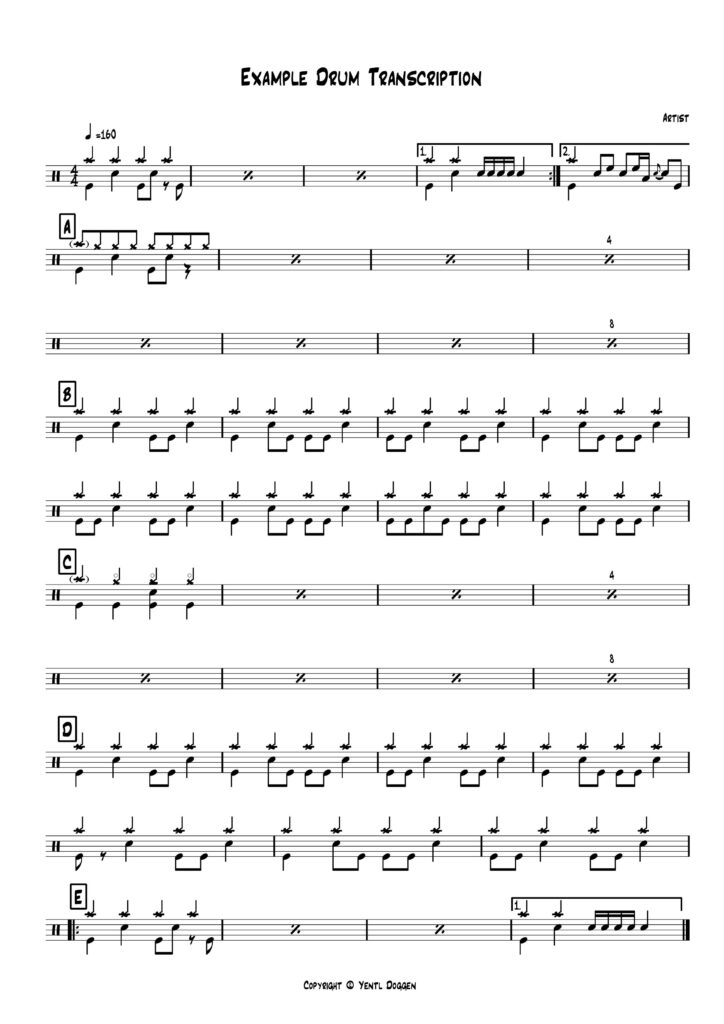
Become a Pro at reading Drum Sheet Music:
Although there are multiple posts to write about how to become better at reading Drum Transcriptions, I’d like to end this last chapter with some valuable tips and tricks. However, please note that reading drum and music notation is a skill that requires practice and repetition.
Breaking down difficult passages:
First things first, and before attempting to play a Drum Transcription, try to find all the challenging passages. There’s no point in playing the complete transcription if you know you will get stuck halfway. Identify and then break them into smaller, more manageable parts. Isolate a section and practise on a slow tempo. Once you can play the section accurately and consistently at a slow tempo, you can gradually increase until you reach full tempo.
Building a Library of Knowledge:
Playing drum transcriptions can be very challenging, depending on your skill level or the song you are playing. The more you play, the better you’ll become. If you have an extensive library of grooves and beats that you can play without practice, it becomes easier with every transcription you’ll play. Keep practising techniques, and keep reading transcriptions. Practice does make perfect.
Become a Metronome:
To improve your timing and accuracy when playing music, practising with a metronome is essential. Don’t just play along with your favourite songs – try playing different passages at various tempos. Consider using a metronome with silent bars to help you gauge your tempo and ensure you’re playing accurately. With time, this will help you develop a strong sense of timing and consistently improve your ability to play notation.
Practise:
It’s important to remember that mastering the skill of reading drum notation requires time and practice. However, with dedication and hard work, anyone can become a skilled and versatile drummer capable of reading and playing a wide range of drum notation. Keep practising, stay motivated, and enjoy exploring the endless possibilities of drum notation!

Do you want to know more about Yentl’s life as a musician? Check out the Music, Projects and Online Education pages. My website has multiple ways to keep in the loop with music and travel-related updates. Follow my Instagram and Facebook pages to get the latest content on your socials. To get the updates in your mailbox, subscribe to the newsletter. I will post plenty of free drum lessons and other music and drum-related advice on this website in the future! Check out the drum transcriptions if you haven’t already. We can’t build this platform without our readers, so we thank you for your continued support. Stay tuned for many more to come!


